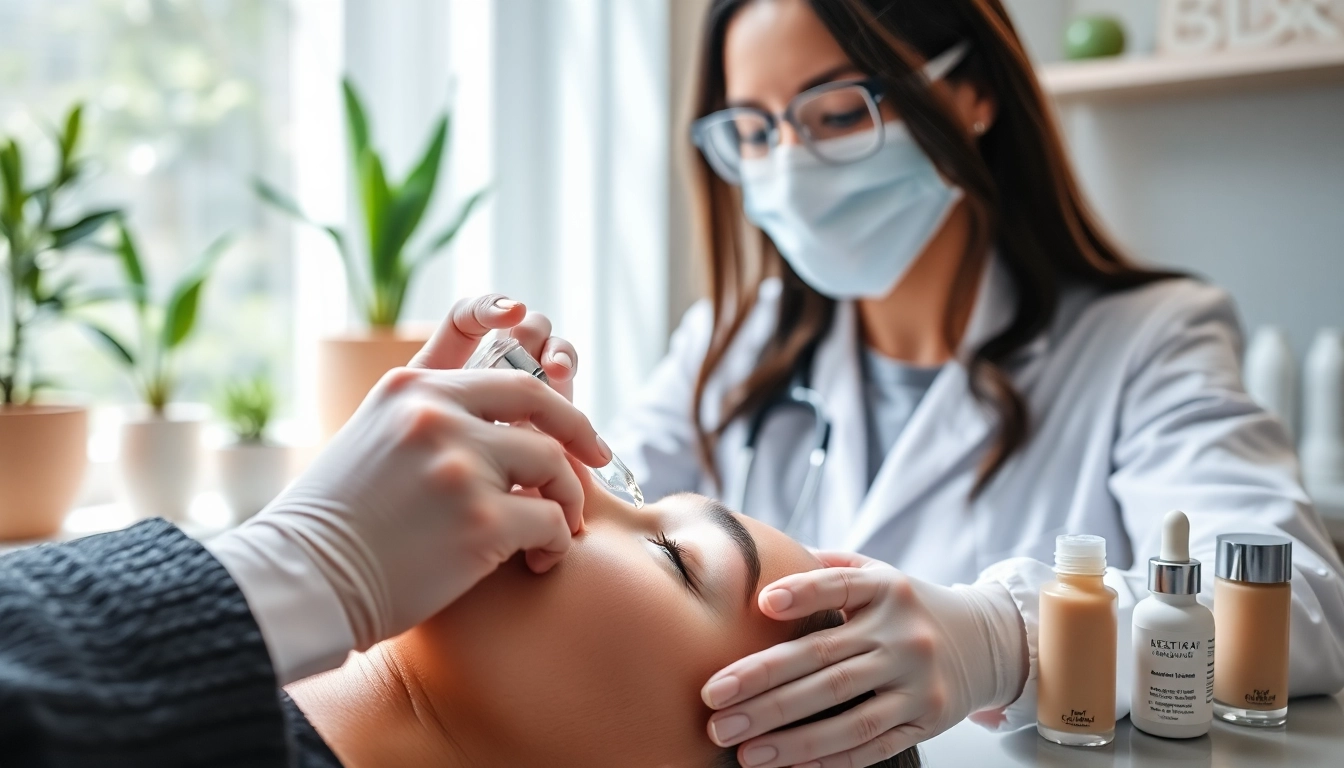Understanding Wrinkles and Their Causes
Wrinkles are a natural part of the aging process, though they can often occur prematurely due to various factors. They can be defined as creases or folds in the skin that develop over time as a result of several biological and environmental influences. Understanding these causes can help individuals make informed decisions about their skin care and treatment options. For comprehensive Wrinkle Treatments, it’s essential to explore the underlying biology of the skin, the different types of wrinkles, and the external factors that accelerate skin aging.
The Science Behind Aging Skin
As we age, our skin undergoes a variety of structural changes that contribute to the formation of wrinkles. One of the most crucial factors is the decrease in collagen and elastin production, two proteins that maintain skin’s firmness and elasticity. From our mid-20s onward, collagen production starts to decline, leading to a loss of volume and structure in the skin. Additionally, the skin’s ability to retain moisture diminishes due to reduced hyaluronic acid levels, which further contributes to the visible signs of aging.
Skin cell turnover slows down, meaning that dead skin cells remain on the surface longer, resulting in a duller complexion. The connective tissues within the skin also become weaker and less supportive, which can exacerbate wrinkle development. Understanding these biological processes is crucial for selecting appropriate wrinkle treatments that can effectively address these age-related changes.
Common Types of Wrinkles
Wrinkles can generally be categorized into two main types: dynamic and static. Dynamic wrinkles are caused by muscle movement and generally manifest during expressions such as smiling or frowning. These are most commonly observed around the forehead, eyes, and mouth, and include fine lines and crow’s feet. Static wrinkles, on the other hand, are present even when the face is at rest and are primarily due to loss of collagen, elasticity, and hydration in the skin.
Other types of wrinkles include fine lines, which are typically shallow and often appear first, and deeper folds that develop as skin loses its fullness over time. Recognizing the different types of wrinkles can aid in determining the most effective treatment options available.
Environmental Factors Contributing to Skin Aging
In addition to intrinsic aging, environmental factors play a significant role in the acceleration of skin aging and wrinkle formation. Sun exposure is one of the predominant external factors; UV radiation can damage collagen and elastin fibers, leading to premature aging signs. Smoking is another crucial contributor as it reduces blood flow to the skin, depriving it of essential nutrients and oxygen. Moreover, pollution and the use of harsh skincare products can further irritate the skin and prompt early wrinkle formation.
Factors such as diet and hydration also influence skin health. Diets high in sugar and processed foods can promote glycation, which damages proteins in the skin and leads to aging effects. Consuming a balanced diet rich in antioxidants, vitamins, and minerals can protect the skin from aging. Understanding these factors is essential for anyone looking to maintain youthful skin and minimize the appearance of wrinkles.
Popular Wrinkle Treatments Explained
With advancements in cosmetic technology and dermatological sciences, a variety of effective wrinkle treatments are available today. Each treatment option varies in terms of methodology, invasiveness, effectiveness, and cost. The decision on which treatment to pursue often depends on individual preferences, skin types, and specific concerns about aging skin. In this section, we’ll explore some of the most popular treatments available today.
Injectable Options: Botox and Fillers
Injectable treatments have gained immense popularity in recent years for their effectiveness and minimal downtime. Botox, a neurotoxin derived from the bacterium Clostridium botulinum, is widely used to treat dynamic wrinkles. It works by temporarily paralyzing the facial muscles that cause expression lines, effectively smoothing out the skin. The results typically last three to six months, making it a popular choice for both men and women looking for swift results without surgery.
Dermal fillers, on the other hand, are used to address static wrinkles and facial volume loss. These fillers, made from substances like hyaluronic acid, can plump up areas that have lost volume, smooth out fine lines, and enhance facial contours. The effects of fillers can last anywhere from several months to a couple of years, depending on the type used and the area treated.
It’s vital for patients to consult with a qualified practitioner to determine the most suitable type of injectables for their concerns and to set realistic expectations regarding the outcomes.
Non-Invasive Treatments: Laser and Microneedling
Non-invasive treatments have also become increasingly popular due to their ability to rejuvenate the skin without the need for surgical intervention. Laser treatments, including fractional CO2 and non-ablative lasers, work by targeting the deeper layers of the skin to stimulate collagen production. This results in firmer, smoother skin with reduced appearance of wrinkles. Although multiple sessions may be required, downtime varies, making it an appealing option for those seeking a gradual yet effective solution.
Microneedling, another non-invasive technique, involves creating tiny micro-injuries in the skin using fine needles to promote healing and collagen production. It’s particularly effective for improving skin texture, reducing fine lines, and enhancing overall skin appearance. While results are often visible soon after treatment, the effects continue to improve over several months as collagen builds up.
Surgical Alternatives: Facelifts and Brow Lifts
For those seeking more dramatic results, surgical options such as facelifts and brow lifts are available. A facelift, or rhytidectomy, involves removing excess skin and tightening facial tissues to create a more youthful appearance. It is especially effective for deep wrinkles and sagging skin around the jawline, cheeks, and neck.
A brow lift, on the other hand, targets wrinkles on the forehead and improves drooping eyebrows. These surgical procedures generally offer long-lasting results, but they do come with longer recovery times compared to non-surgical methods. Before proceeding with any surgical option, it’s important to discuss the risks, recovery process, and expected outcomes with a qualified plastic surgeon.
Choosing the Right Wrinkle Treatment for You
With an array of wrinkle treatments available, it’s crucial to choose the right one that aligns with your skin type, age, and overall aesthetic goals. Consideration of these factors can help streamline the decision-making process and ensure satisfactory outcomes.
Assessing Your Skin Type and Age
Your skin type plays a significant role in determining which treatments will be most effective. For instance, individuals with oily skin may benefit from treatments that address enlarged pores and uneven texture, while those with dry or sensitive skin may need more hydration-focused treatments. Additionally, age is a factor; younger individuals may prefer non-invasive techniques for preventative measures, whereas older individuals may require more intensive treatments to address deeper wrinkles.
Consultation: What to Expect
Consultation with a qualified dermatologist or cosmetic specialist is an essential step in the treatment journey. During this initial meeting, you should expect a thorough discussion of your skin concerns, medical history, and an assessment of your skin’s condition. Practitioners will typically provide insights into suitable treatment options, potential outcomes, and any associated risks. This is also the perfect opportunity to ask questions and address any fears about the treatment process.
Tailoring Treatments to Personal Goals
Your wrinkle treatment plan should align with your personal health goals and lifestyle choices. Treatment plans can often be integrated with skincare routines and other wellness considerations. For example, if your goal is to achieve a subtle, natural appearance, non-invasive options may align better with your objectives. On the other hand, if you are seeking dramatic improvement, surgical options might be more suitable. Qualifying your objectives with the expertise of a trained specialist can lead to a tailored plan that brings your vision to life.
Aftercare and Maintenance for Best Results
Effective aftercare is crucial to ensure that the results from wrinkle treatments are long-lasting. Your skin goes through a healing process after many treatments, and appropriate post-care can significantly enhance overall results.
Skincare Routine Post-Treatment
Following treatment, it’s important to establish a skincare routine that promotes healing and maintains the results. This may include gentle cleansing, moisturizing, and applying sunscreen to protect newly treated areas. Insights from your dermatologist regarding product choices are essential, as certain ingredients can exacerbate skin sensitivity or interfere with results.
Long-term Maintenance Strategies
Long-term maintenance is essential for sustaining the benefits of wrinkle treatments. Regular follow-up treatments may be necessary, especially for injectables like Botox and fillers that require periodic re-administration for continued results. Moreover, utilizing high-quality skincare products that focus on hydration and collagen production can enhance and prolong the effects of your treatments. A preventative approach involving healthy lifestyle choices, including a balanced diet and smoking cessation, can also support skin health.
The Importance of Regular Dermatologist Visits
Committing to regular check-ups with a dermatologist can be invaluable in monitoring your skin’s health and making necessary adjustments to your skincare routine and treatments. These visits can also help catch any skin concerns early, ensuring that proactive measures are taken to maintain youthful skin. Your dermatologist can guide you in recognizing changes in your skin and provide personalized advice for ongoing care.
Debunking Myths About Wrinkle Treatments
With the increasing popularity of wrinkle treatments, numerous myths and misconceptions have emerged that can lead to confusion among patients. It is important to address these myths to foster informed decisions regarding treatment options.
Common Misconceptions About Botox and Fillers
One of the most prevalent misconceptions about Botox is that it makes individuals appear expressionless; however, when administered correctly, Botox can enhance facial aesthetics while preserving natural expressions. Similarly, fillers are often thought to result in an exaggerated or “puffy” appearance; however, employing the right technique and suitable product can yield subtle and balanced outcomes. Choosing an experienced professional is crucial to achieving the desired results.
Understanding the Risks and Side Effects
Like any cosmetic treatment, injectable options come with potential risks and side effects. These can range from mild discomfort to more serious complications, albeit rarely. It’s vital to have open discussions with your practitioner regarding these risks and receive guidance on how to minimize them. Ensuring that the treatment is performed by a qualified and experienced provider is also critical in mitigating potential side effects.
Realistic Expectations: What Treatments Can Achieve
Setting realistic expectations for any wrinkle treatment is essential. While many treatments can provide impressive results, they are not a replacement for natural aging processes. Understanding that each treatment has limitations and that results can vary between individuals will help set a more attainable standard for the outcomes. Comprehensive discussions with professionals can help clarify what is achievable and align your goals with feasible outcomes.



